Imagine a party that lasts an entire week, during which the streets are decorated with flowers, the houses are specially adorned and filled with food and laughter, and where people gather to celebrate the beginning of a new year. In Vietnam, it is the Lunar New Year Tet, the most important holiday in the country.
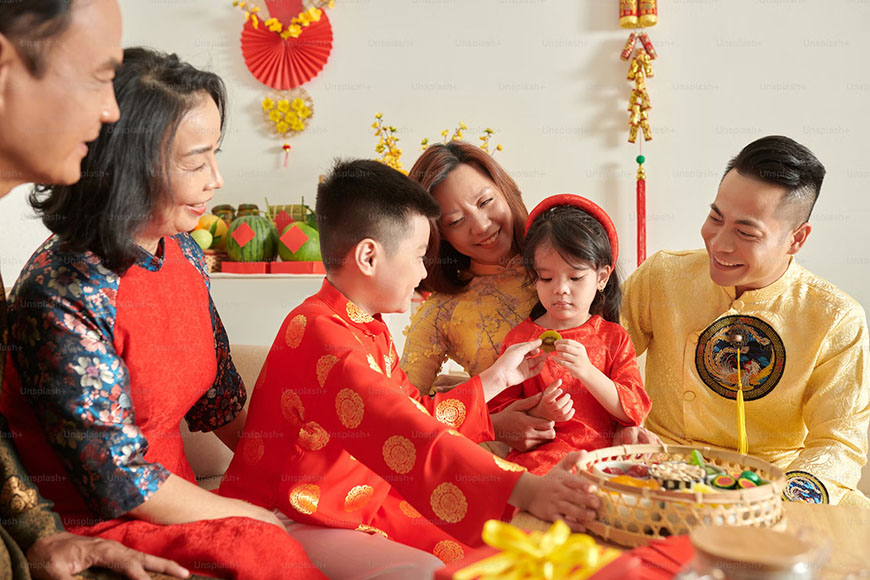
Celebrating Lunar New Year in Vietnam - Photo : Internet
Introduction
Tet dates back to prehistoric times. Originally, it was an agricultural festival marking the beginning of a new cycle of rice cultivation. On this occasion, the Vietnamese made offerings to the Spirits of the land and rice.
Tet has become a more complex holiday over time, incorporating aspects of Vietnamese spirituality and culture. The Lunar New Year Festival is currently the most important holiday in the Land of the Dragon. It is an opportunity for Vietnamese to get together as a family and celebrate the new year.
Tet is celebrated for a week, between the 29th day of the 12th lunar month and the 3rd day of the 1st lunar month, that is to say between the end of January and the beginning of February, according to the luni-solar calendar, based on the cycles of the moon and the sun. February 10 is scheduled for 2024. The Lunar New Year is also known as Têt Nguyen Dan, which means «Feast of the arrival of the first day».
Legends & folklore anecdotes around Têt Nguyen Dan
The legend of Ong Tao
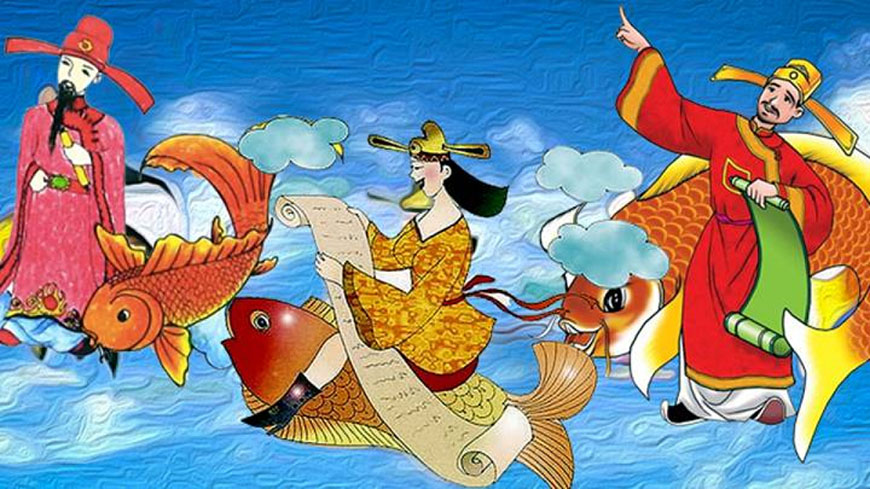
Tet Ong Tao - Photo : Internet
A long time ago, a man who worked as a lumberjack and his wife (a woman named Thi Nhi) were happy in a small village. One day the farm worker realized he was unable to have children. The unfortunate husband began to drink and abuse his wife. Unable to bear it, she left him and married a hunter from a nearby village. One day, the lumberjack, plagued by loneliness and remorse, decided to go to his ex-wife’s house to apologize. In the meantime, the hunter returned home. The young woman hid her first husband in a thatched barn near the kitchen where the hunter smoked his game, to avoid any misunderstanding. Unfortunately, an ember escaped the hearth and set fire to the barn. The young woman, frightened, went to the burning stable to save her ex-husband. The hunter followed her to help, but all three died in the fire. From his heavenly throne, the Emperor of Jade (Ngọc hoàng), deeply touched by this sad fate, divined the three unfortunate and charged them to take care of the welfare of the Vietnamese at the advantageous location of the kitchen. From then on, they became the geniuses of the Foyer, known as Ong Tao.
Every year, on the 23rd day of the last lunar month, Ong Tao leaves home to report to the Jade Emperor on the family’s actions over the past year. The Vietnamese celebrate this feast, called "Têt Ông Táo", by preparing a festive meal and making offerings to the geniuses of the household. This year 2024, Uncle Tao will return his report to the Jade Emperor on February 2 of the Gregorian calendar.
The legend of the 12 animals of the Chinese zodiac
Tet Nguyen Dan is also related to the Chinese zodiac. According to legend, the Buddha summoned all animals for a competition. The purpose of the contest was to determine which animal would cross the river first. It would then be chosen to symbolize the first year of the Chinese lunar cycle.
All animals prepared for the competition. The rat, the ox, the tiger, the rabbit, the dragon, the serpent, the horse, the ram, the monkey, the rooster, the dog and the pig rushed to the river.
Not only was the rat the smallest, but he was also the most cunning. He hid behind the ox, which was the most powerful animal. The ox crossed the river easily, and the rat jumped off the back of the ox just before it reached the other bank.
Thus, the rat first arrived on the opposite bank, becoming the first animal of the Chinese zodiac. The second place was occupied by tiger, followed by rabbit, dragon, snake, horse, ram, monkey, rooster, dog and pig.
Since then, the twelve animals of the Chinese zodiac are linked to a twelve-year cycle. Each year is represented by a different animal, and people born in a given year are supposed to have the character traits of the associated animal. 2024 is the year of the Dragon.
The legend of bánh chưng and bánh dầy
.jpg)
Banh Chung to celebrate Lunar New Year in Vietnam - Photo : Internet
At the time of King Hung Vuong VI, there was a young prince named Lang Lieu. He was the poorest of his brothers and had lost his mother in his childhood. One day, the king launched a contest to determine who would be his successor. The new king would be the prince who would prepare the best dish.
With the exception of Lang Lieu, all the princes ventured to discover the most precious and exotic ingredients. On the other hand, Lang Lieu stayed home and looked for ideas for cooking. He remembered his mother and what she would have liked him to eat.
One night, Lang Lieu had a dream. His mother appeared before him and ordered him to prepare two different dishes: a square dish named bánh chưng and a round dish named bánh dầy. Banh chung would consist of pork, banana leaves, mung beans and glutinous rice. Banh day would be made from sticky rice and sugar.
Lang Lieu got up and set to work. He prepared the ingredients according to his mother’s instructions. With its square shape and rich ingredients, banh chung was a symbol of the earth. With its round shape and softness, the banh day was a symbol of heaven.
The princes presented their dishes to the king on the day of the competition. Lang Lieu’s banh chung and banh day enchant the king as soon as he tasted them. He said Lang Lieu would win the contest and become the new king.
King Lang Lieu became a wise and virtuous man. He governed Vietnam for many years and helped make it prosperous.
During Têt Nguyen Dan, banh chung and banh day became traditional dishes. They represent prosperity, family unity and filial piety.
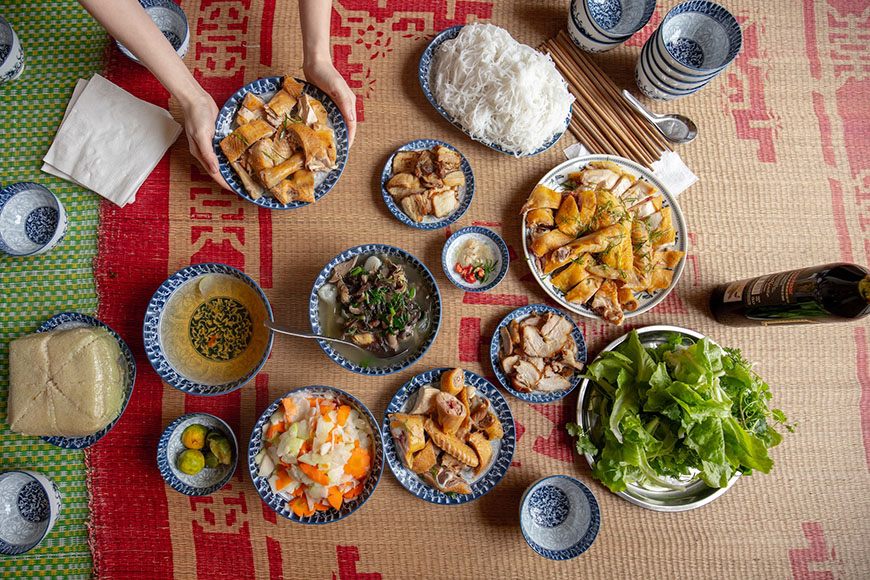
Lunar New Year special dishes - Photo : Internet
The legend of the New Year’s gate
The Vietnamese New Year’s Gate, or cĭng nhà, is a traditional decoration that hangs on the front door of houses during Têt Nguyen Dan. It is supposed to protect the house and its inhabitants from evil spirits and bring good fortune.
Cong Nha are usually made from bamboo, cloth or colored paper. Traditional motifs, which are believed to have magical powers, include animals (which represent strength and protection), flowers (qsymboles of beauty and prosperity), coins and red ribbons, etc. They are generally available in markets or specialty stores. They can also be made by families.
The doors of the New Year also symbolize joy and hope at the beginning of a new year, a period of new beginnings.
The superstitions of the Tet
Lunar New Year is a celebration filled with superstitious beliefs that are more or less honored to guarantee a successful year.
- • On the day of Tet, it is worth refraining from washing one’s hair, throwing away antique objects or offering knives or sharp objects, as this could lead to misfortunes.
- • Do not sweep the house: During the first three days of the New Year, sweeping the house is considered a bad omen because it would sweep away the good fortune of the house.
- • Do not argue during the New Year: this is considered a bad omen because it would bring unhappiness to the family during the coming year.
- • Don’t wear white or black clothes: In Vietnam, black and white clothes are traditionally associated with funerals, so it is considered a bad omen to wear them during the New Year festivities.
- • Avoid eating duck or shrimp meat: Shrimp and duck meat are considered ominous foods because they are linked to poverty. Moreover, shrimp swim backwards meaning your plans for the year will stall.
- • Don't give water or fire away. Both water and fire are considered auspicious elements: fire because it is red, the color of luck, and water because an urn full of water represents riches and bounty. The Vietnamese also think that "money flows like water," therefore homes will stock up on water and fuel their fireplaces to avoid running out.
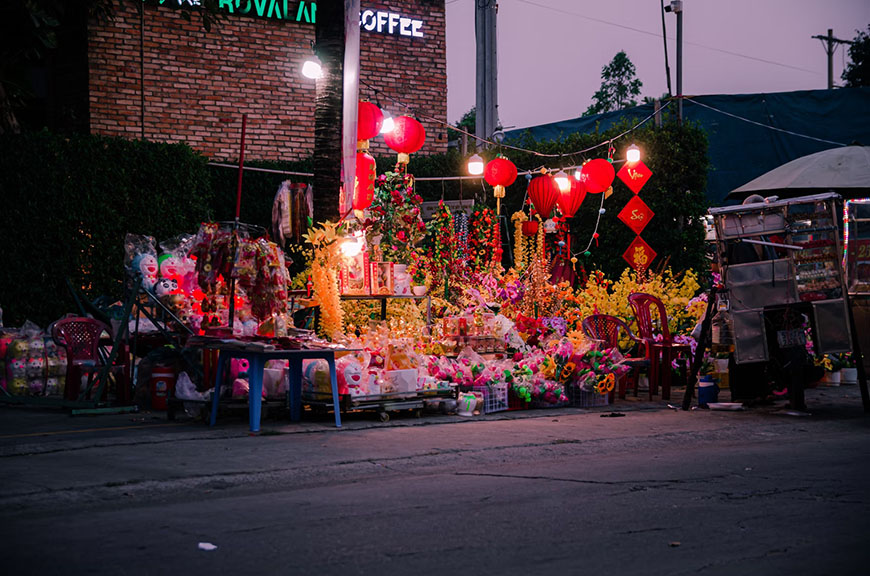
Street vendor od Tet decorations - Photo : Internet
Some essential traditions of Têt Nguyen Dan
Lunar New Year Celebration is a multi-day celebration with the following key moments:
- • Celebrate ancestors: Vietnamese families gather on the first day of the New Year to celebrate and pay tribute to their ancestors. On the altar of the ancestors, they light candles and incense sticks and offer offerings of food and flowers. During the coming year, they pray for the prosperity and happiness of their families. The Vietnamese believe their ancestors are still there, protecting and guiding them. Thus, Têt Nguyen Dan offers Vietnamese a crucial opportunity to connect with their ancestors and express their gratitude.
- • Cleaning the house: Before Tet, the Vietnamese clean their house to eliminate the bad energies of the previous year. Then they put flowers, lanterns and banners to embellish them.
- • Buy new clothes: The Vietnamese buy new clothes for the Tet to symbolize rebirth.
- • Cooking traditional Tet dishes: Vietnamese prepare banh chung, banh tet and nem. In addition, they prepare candied fruits called Mut for their guests and visitors. Fruits, vegetables, flowers and traditional dishes adorn the New Year’s table. Each component of the table has a symbolic meaning. Round fruits, such as oranges and mandarins, are symbols of prosperity.
- • Visiting the family: To celebrate Tet, the Vietnamese go to their family. Tet offers families an opportunity to come together and celebrate the New Year together.
- • Offering Li Xi: these are red envelopes decorated with traditional motifs - such as flowers, animals or luck symbols - and containing a small amount of money, which are traditionally given to children. The custom of the Li Xi is considered a symbol of luck, happiness and prosperity.
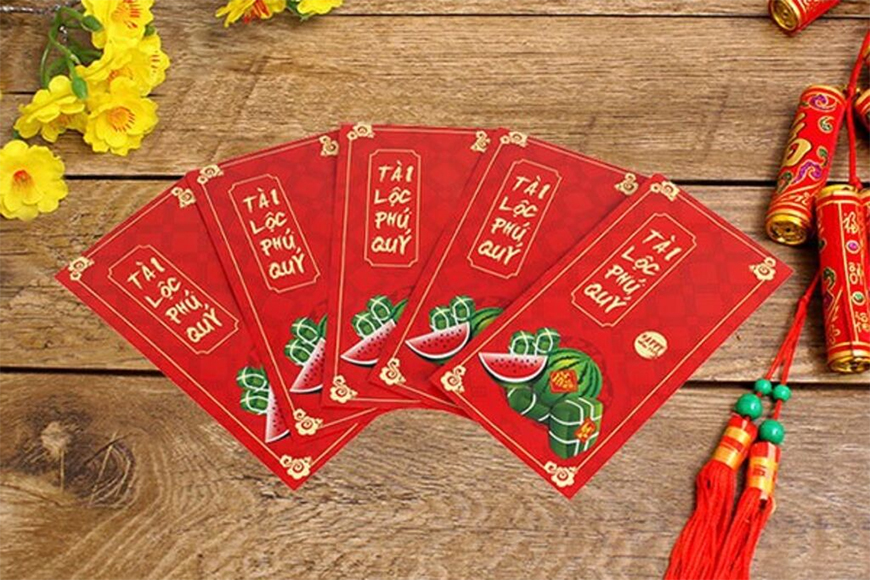
Li Xi envelopes - Photo : Internet
Conclusion
Tet Nguyen Dan, also known as the Lunar New Year Festival, is the most important traditional festival in Vietnam.Itfree lasts for several days and is marked by many cultural and spiritual activities, in a spirit of rich in traditions, symbols and meanings. It is an opportunity for Vietnamese to get together as a family and celebrate the beginning of the new year.